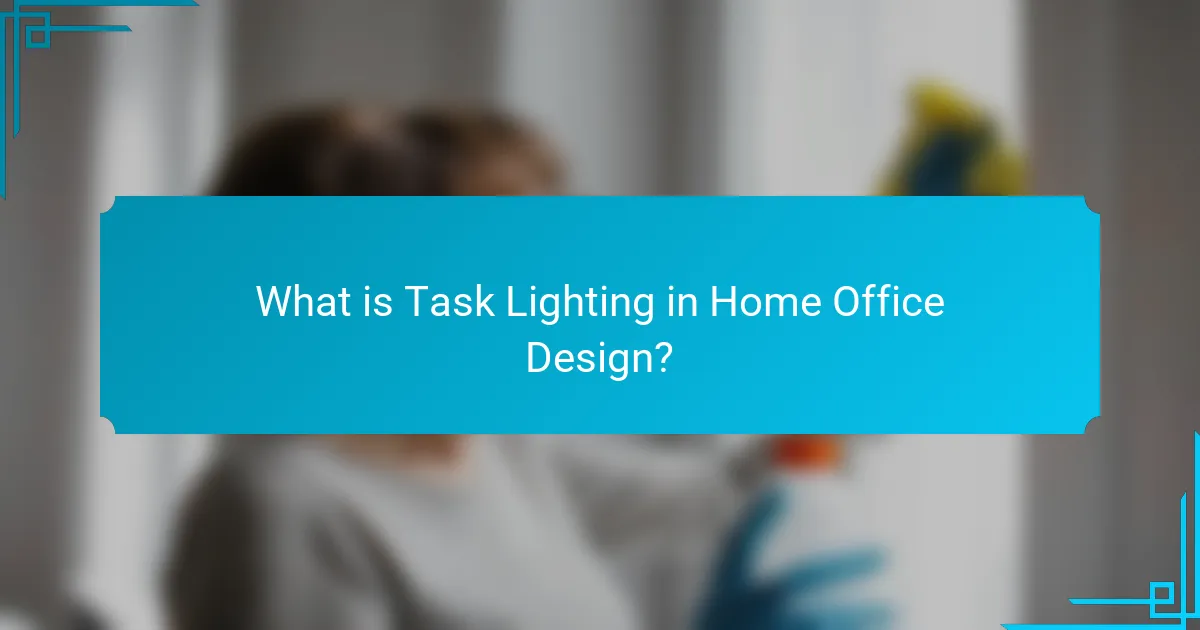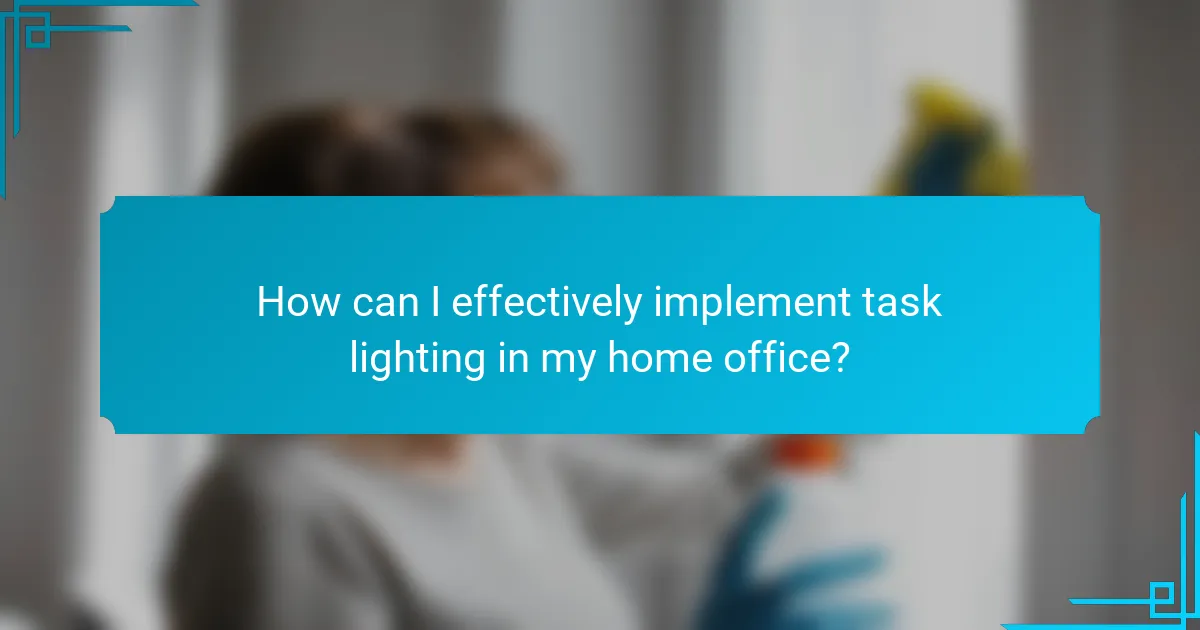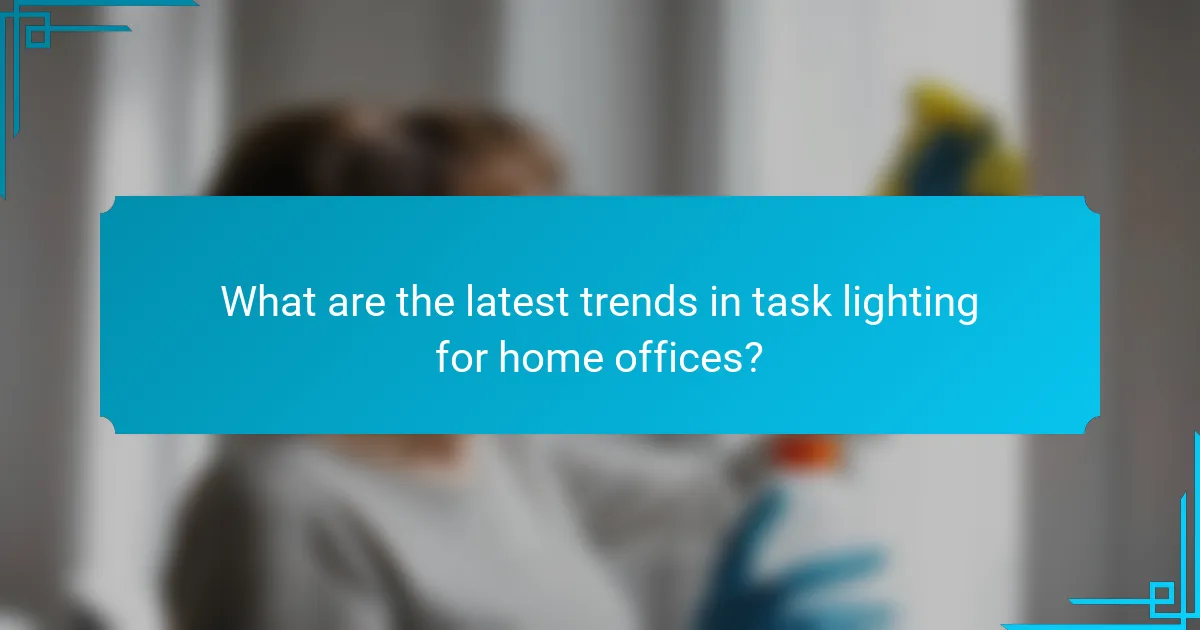Task lighting is a focused illumination essential for enhancing visibility in home office environments, particularly during activities such as reading, writing, and computer use. This article outlines best practices for effectively incorporating task lighting to reduce eye strain and improve productivity, highlighting common forms like desk lamps, under-shelf lights, and adjustable wall sconces. It emphasizes the importance of proper positioning to minimize glare and shadows, and discusses the benefits of using LED technology and smart lighting systems. Recent trends indicate that well-designed task lighting can significantly boost work efficiency, with studies showing that adjustable and smart lighting options lead to improved focus among home office workers.

What is Task Lighting in Home Office Design?
Task lighting in home office design is focused illumination that enhances visibility for specific tasks. This type of lighting is essential for activities such as reading, writing, and using a computer. It helps reduce eye strain and improves productivity. Common forms of task lighting include desk lamps, under-shelf lights, and adjustable wall sconces. Proper task lighting should be positioned to minimize shadows and glare. Research indicates that well-designed task lighting can increase work efficiency by up to 20%. Thus, incorporating effective task lighting is crucial for an optimal home office environment.
How does task lighting differ from general lighting?
Task lighting is specifically designed to illuminate areas where detailed tasks are performed. General lighting, on the other hand, provides overall illumination for a space. Task lighting focuses on specific work areas, enhancing visibility for activities like reading or writing. General lighting aims to light an entire room uniformly. Task lighting often uses directed fixtures like desk lamps or under-cabinet lights. General lighting typically includes ceiling fixtures or chandeliers. The effectiveness of task lighting can reduce eye strain during close-up work. In contrast, general lighting creates a comfortable ambiance for the whole environment.
What are the primary purposes of task lighting?
Task lighting primarily serves to illuminate specific areas for focused activities. It enhances visibility for tasks such as reading, writing, and crafting. Proper task lighting reduces eye strain by providing adequate brightness where needed. It also improves productivity by creating a well-lit workspace. Task lighting can be adjustable to suit individual preferences. It often includes features like dimming capabilities for flexibility. Effective task lighting is essential in home offices to maintain comfort and efficiency. Studies show that well-lit environments can boost work performance significantly.
How does task lighting enhance productivity in a home office?
Task lighting enhances productivity in a home office by providing focused illumination for specific tasks. It reduces eye strain by ensuring adequate light on work surfaces. Proper task lighting increases concentration by minimizing distractions from shadows and glare. Studies show that well-lit workspaces can improve mood and energy levels. According to a study by the American Society of Interior Designers, 68% of workers report increased productivity in well-lit environments. Task lighting can also help maintain a consistent workflow by clearly defining work areas. This targeted lighting supports better organization and efficiency in task completion.
What types of task lighting are ideal for home offices?
Ideal task lighting for home offices includes desk lamps, floor lamps, and under-cabinet lights. Desk lamps provide focused light for writing or reading. They often feature adjustable arms for flexibility. Floor lamps can illuminate larger areas while providing ambient lighting. Under-cabinet lights are effective for illuminating workspaces without taking up desk space. LED options are energy-efficient and long-lasting. Proper task lighting reduces eye strain and enhances productivity. Studies show that adequate lighting can improve focus and efficiency in work environments.
What are the advantages of using desk lamps as task lighting?
Desk lamps provide focused illumination, enhancing visibility for specific tasks. They reduce eye strain by directing light exactly where it is needed. This targeted lighting improves concentration and productivity during work. Desk lamps are adjustable, allowing users to modify light direction and intensity. Many models offer various brightness settings, catering to different tasks. They occupy minimal space on desks, making them practical for home offices. Desk lamps can also enhance the aesthetic of a workspace, contributing to overall design. Their portability allows easy relocation, adapting to different work environments.
How can floor lamps serve as effective task lighting solutions?
Floor lamps can serve as effective task lighting solutions by providing focused illumination for specific activities. They often feature adjustable heights and angles to direct light where it is needed most. This adaptability makes them suitable for reading, writing, or other detailed tasks. Additionally, many floor lamps come with brightness settings to customize light intensity. The use of LED bulbs in floor lamps offers energy efficiency and longevity. A well-placed floor lamp can reduce eye strain by minimizing shadows and glare. Their versatility allows for easy integration into various home office designs. Studies show that proper lighting can enhance productivity and concentration, making floor lamps a practical choice.
What role do wall-mounted lights play in task lighting?
Wall-mounted lights serve a crucial role in task lighting by providing focused illumination for specific activities. They can be positioned to direct light onto work surfaces, enhancing visibility and reducing eye strain. Wall-mounted lights are particularly effective in home offices where desk space may be limited. They free up valuable desk space while ensuring adequate lighting for reading, writing, or using a computer. Adjustable designs allow users to customize light direction based on their needs. Studies indicate that proper task lighting can improve productivity and comfort in work environments. Overall, wall-mounted lights are essential for creating a functional and well-lit workspace.
What factors should be considered when designing with task lighting?
When designing with task lighting, several factors must be considered. First, the type of tasks being performed influences lighting requirements. Tasks like reading or writing require focused, bright light. Second, the placement of light sources should minimize shadows and glare. Proper positioning enhances visibility and comfort. Third, adjustable lighting options allow users to customize brightness levels. This adaptability caters to different tasks and personal preferences. Fourth, the color temperature of the light affects mood and productivity. Warmer tones create a cozy atmosphere, while cooler tones promote alertness. Lastly, energy efficiency is crucial for sustainability. LED lights are commonly recommended for their longevity and low energy consumption. These factors collectively ensure effective and comfortable task lighting in home office designs.
How does the layout of a home office affect task lighting choices?
The layout of a home office significantly influences task lighting choices. A well-planned layout considers the placement of furniture and equipment. For instance, desks positioned near windows benefit from natural light. This reduces the need for additional lighting during the day. Conversely, a layout that isolates the desk from natural light sources requires more artificial lighting.
Light fixtures should be strategically placed based on the desk’s orientation. If the desk faces a wall, overhead lighting becomes essential. Task lamps can enhance focused illumination for specific areas. The overall room design also impacts light distribution. Open layouts may allow for more ambient light, while closed spaces may require layered lighting solutions.
In summary, the home office layout directly dictates the type and amount of task lighting needed. Proper consideration of this relationship enhances productivity and comfort.
What is the importance of light color temperature in task lighting?
Light color temperature is crucial in task lighting as it influences visibility and comfort. Cooler color temperatures, typically above 4000K, enhance alertness and focus. These temperatures are ideal for detailed tasks like reading or writing. Warmer color temperatures, below 3000K, create a cozy atmosphere but may reduce concentration. Studies show that appropriate color temperature improves performance and reduces eye strain. For example, a study by the Lighting Research Center found that cooler light enhances productivity in office settings. Thus, selecting the right light color temperature is essential for effective task lighting.
How can brightness levels impact the effectiveness of task lighting?
Brightness levels significantly impact the effectiveness of task lighting. Proper brightness enhances visibility and reduces eye strain. Insufficient brightness can lead to fatigue and decreased productivity. Conversely, excessive brightness may cause glare, making tasks difficult. A study by the Lighting Research Center found that optimal lighting levels improve concentration and performance. For reading tasks, a brightness level of 300 to 500 lux is recommended. This level supports comfort while ensuring clarity. Adjusting brightness according to the task type is essential for maintaining focus and efficiency.

How can I effectively implement task lighting in my home office?
To effectively implement task lighting in your home office, focus on specific areas where you perform tasks. Use adjustable desk lamps to direct light where needed. Consider LED bulbs for energy efficiency and brightness. Position lamps to reduce glare on screens and surfaces. Ensure the color temperature of the light promotes alertness; 4000K to 5000K is ideal. Layer lighting by combining overhead lights with task lighting for a balanced effect. Regularly assess your lighting needs as tasks may change. Proper task lighting can enhance productivity and reduce eye strain.
What are the best practices for positioning task lighting?
Position task lighting to minimize shadows and glare. Place the light source beside or directly in front of the task area. This ensures even illumination on the work surface. Avoid positioning lights behind the user to prevent shadows. Use adjustable fixtures to direct light as needed. Consider the height of the light source; it should be above the work surface to provide optimal illumination. For desk work, a height of 15 to 30 inches above the surface is recommended. Ensure the color temperature of the light matches the task requirements; cooler temperatures enhance focus.
How far should task lights be placed from work surfaces?
Task lights should be placed 20 to 30 inches above work surfaces. This height provides optimal illumination without causing glare. Proper positioning enhances visibility for tasks such as reading or writing. Additionally, it prevents shadows that can hinder productivity. Studies show that adequate lighting improves focus and reduces eye strain. Following this guideline helps create an effective workspace.
What angles are most effective for directing task lighting?
The most effective angles for directing task lighting are typically between 30 to 45 degrees. This angle helps to minimize glare while providing adequate illumination for focused tasks. Lighting positioned at these angles enhances visibility without causing eye strain. A study by the Illuminating Engineering Society emphasizes that proper angling reduces shadows and improves light distribution. Adjusting the angle based on the specific task can further optimize lighting effectiveness. For example, reading tasks benefit from a 45-degree angle, while close-up work may require a steeper angle for better focus.
What common mistakes should be avoided when using task lighting?
Common mistakes to avoid when using task lighting include improper placement of light sources. Positioning lights too far from the work area can create shadows and reduce visibility. Additionally, using overly bright or harsh lighting can cause glare, leading to eye strain. Failing to adjust light angles can also result in insufficient illumination. Another mistake is neglecting to consider the color temperature of the light. Using a light that is too warm or too cool can affect concentration and comfort. Lastly, not layering task lighting with ambient light can create an unbalanced lighting environment. These mistakes can hinder productivity and create an uncomfortable workspace.
How can over-illumination affect work efficiency?
Over-illumination can negatively affect work efficiency by causing visual discomfort and fatigue. Excessive brightness leads to glare, making it difficult to focus on tasks. This can result in decreased productivity due to increased eye strain. Workers may experience headaches and reduced concentration levels. Studies indicate that appropriate lighting levels improve overall workplace comfort and performance. Research shows that optimal lighting enhances mood and reduces fatigue, contributing to better work outcomes. Therefore, balancing light intensity is crucial for maintaining efficiency in work environments.
What issues arise from improper placement of task lighting?
Improper placement of task lighting can lead to several issues. One major problem is inadequate illumination, which can cause eye strain and fatigue. When task lighting is too dim, users may struggle to see their work clearly. Conversely, overly bright task lighting can create glare, leading to discomfort and distraction.
Additionally, poor placement can result in shadows on work surfaces. Shadows can obscure important details, making tasks more difficult. This is particularly problematic for activities that require precision, such as reading or crafting.
Another issue is uneven lighting, which can create a visually unappealing workspace. A well-lit area enhances focus and productivity. In contrast, inconsistent lighting can disrupt workflow and reduce efficiency.
Lastly, improper placement may interfere with the overall aesthetics of the room. Task lighting should complement the design of the space. When it does not, it can detract from the overall ambiance and functionality of the home office.

What are the latest trends in task lighting for home offices?
The latest trends in task lighting for home offices include the use of LED technology, adjustable fixtures, and smart lighting systems. LED lights offer energy efficiency and long lifespan, making them popular for home office setups. Adjustable fixtures, such as swing-arm lamps, allow users to direct light where it is needed most. Smart lighting systems enable users to control brightness and color temperature through mobile apps or voice commands. These features enhance productivity and comfort in a workspace. According to a 2023 study by the American Lighting Association, 75% of home office workers reported improved focus with adjustable and smart lighting options.
How are smart lighting solutions changing task lighting design?
Smart lighting solutions are transforming task lighting design by offering enhanced control and adaptability. These systems allow users to adjust brightness and color temperature according to specific tasks. For instance, warmer tones can promote relaxation during reading, while cooler tones enhance focus for detailed work.
Smart lighting can be programmed to change automatically based on the time of day. This feature supports circadian rhythms, improving overall well-being and productivity. Additionally, integration with smart home systems enables seamless control via voice commands or mobile apps.
The market for smart lighting is growing rapidly, with a projected value of $80 billion by 2026, indicating strong demand and innovation in this area. These advancements reflect a shift towards more personalized and efficient lighting solutions in home office environments.
What benefits do adjustable and multi-functional task lights offer?
Adjustable and multi-functional task lights provide versatility and enhanced functionality. They allow users to direct light precisely where needed. This feature improves visibility for detailed tasks. Adjustable lights can cater to different work activities, from reading to crafting. Multi-functional designs often include features like color temperature adjustments. This adaptability supports various moods and productivity levels. Studies show that proper lighting can reduce eye strain and fatigue. Effective task lighting can increase focus and efficiency in home office settings.
How can sustainable lighting options enhance a home office environment?
Sustainable lighting options can enhance a home office environment by improving energy efficiency and creating a healthier workspace. These lighting solutions often utilize LED technology, which consumes up to 75% less energy than traditional incandescent bulbs. Additionally, sustainable lighting options reduce carbon footprints, contributing to environmental conservation. They can also provide better illumination quality, which is crucial for productivity and reducing eye strain. Natural light-enhancing designs, such as skylights or strategically placed windows, can further boost mood and focus. According to the U.S. Department of Energy, proper lighting can increase worker productivity by up to 20%. Sustainable lighting thus not only benefits the environment but also promotes a more effective and pleasant working atmosphere.
What practical tips can improve task lighting in my home office?
To improve task lighting in your home office, consider using adjustable desk lamps. These lamps provide focused light where you need it most. Position the lamp to reduce glare on screens and surfaces. Use LED bulbs for energy efficiency and bright illumination. Incorporate multiple light sources to create an even distribution of light. Natural light is beneficial; position your desk near windows when possible. Use light-colored walls to reflect light and enhance brightness. Dimmable lights offer flexibility for different tasks and moods. Regularly clean light fixtures to maintain optimal brightness.
How can I choose the right task lighting for my specific needs?
To choose the right task lighting for your specific needs, assess the tasks you perform in your workspace. Identify whether you need focused lighting for detailed work or broader illumination for general activities. Select light fixtures that provide adequate brightness, measured in lumens, to suit your tasks. For example, a reading area typically requires around 300-500 lumens. Consider the color temperature of the light; warmer lights (2700K-3000K) are relaxing, while cooler lights (4000K-5000K) enhance focus and alertness. Ensure the light source reduces glare and shadows to prevent eye strain. Adjustable fixtures can provide versatility for different tasks. Finally, consider energy-efficient options like LED bulbs for cost savings and longevity.
What maintenance practices ensure optimal task lighting performance?
Regular cleaning of task lighting fixtures ensures optimal performance. Dust and grime can reduce light output significantly. Inspect bulbs periodically for wear and replace them as needed. Using the correct wattage for bulbs maintains brightness levels. Adjusting the angle of fixtures can enhance light distribution. Checking electrical connections prevents flickering and ensures safety. Ensuring proper placement reduces glare and improves comfort. Following these practices can extend the lifespan of lighting and improve overall workspace efficiency.
Task lighting is a focused illumination method essential for enhancing visibility and reducing eye strain in home office environments. This article covers the significance of task lighting, its differences from general lighting, and the various types, including desk lamps, floor lamps, and wall-mounted lights. It also discusses best practices for positioning, brightness levels, and color temperature to optimize productivity. Additionally, the article highlights the latest trends in task lighting design, including smart and adjustable solutions, and offers practical tips for selecting and maintaining effective task lighting in home offices.